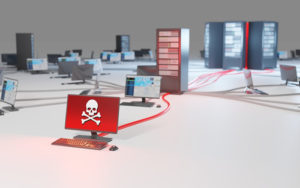Higher education has always been a target for cybercriminals, and the COVID-19 pandemic has only highlighted vulnerabilities in campus IT networks and infrastructure.
Higher education institutions often host sensitive research data, patent information, and a vast amount of student personal data while supporting a sprawling campus of information resources used by students, faculty and others.
The current pandemic has added to these problems and has sent university network administrators scrambling to accommodate the rapid shift to remote, on-line learning, coping with unprecedented traffic volumes on university network infrastructure and a vastly increased risk of security breaches.
Campus IT leaders now face a new set of challenges as they work to protect sensitive data and meet the increasing–and changing–needs of students and faculty.
“While remote access to learning may have been an option in the past, I think it’s pretty clear now that it’s very critical,” said Terry Young, director of Service Provider and 5G Marketing at A10 Networks, during an exclusive webinar with eCampus News. “[COVID] will help accelerate a trend we see happening anyway–more and more remote learning programs. We see this as really accelerating moving forward, with high-quality and resilient access.”
Here are 4 ways COVID has impacted campus IT networks. For a look at what’s coming down the pipeline, check out the full webinar.
1. The move to mobile, which is already on the up-and-up, is huge. By 2025, the world would see 5.8 billion mobile subscribers–about 70 percent of the world’s population. This makes access to all kind of applications, including educational applications, critically necessary. As 5G is deployed, the volume of traffic for mobile educational applications will increase even more.
2. DDoS attacks have skyrocketed–300 percent growth in 2020 alone, in fact. “That’s what’s a little bit of a cause for concern, because when you couple that with powerful IoT devices, and consider how many devices are coming online every single day, it creates a gigantic problem,” said Babur Nawaz Kha, a Technical Marketing Engineer with A10 Networks. “It’s not just the frequency; we’ve also seen an increase in the intensity of attacks.” More than 75 percent of DDoS attacks are less than 5GBPS, which means many of them fly under the radar and go undetected.
3. Service providers need to meet new demands. With a shift off campus, service providers have seen a significant volume increase in data and voice, along with significant shifts in usage patterns as people are learning and working from home. Residential usage has shifted from evening to daytime with marked increases in video streaming, gaming, software downloads, and social media use. As usage shifts from traditional locations like university campuses and goes out to homes, service providers may or may not have all the infrastructure they need to serve those locations.
4. All kinds of cyber activities have sharply increased–including an increase in malicious activities. Cyber attacks aren’t necessarily new, but many are now weaponizing COVID-19 news with phishing emails and other scams. These actions highlight the need for better cybersecurity and resiliency so service providers can continue to offer services.
- First-generation students are more likely to seriously consider leaving college - April 17, 2024
- How higher ed can meet workforce needs - April 15, 2024
- Higher ed leaders believe continuing education units are undervalued - April 10, 2024

